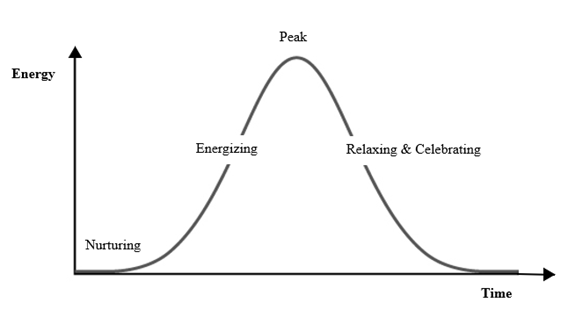Have you ever been in a situation where working with a group makes the work harder than completing the work alone? Many groups struggle to agree on a shared goal and to work on it effectively. In a world where teamwork is essential, knowing how to build the team and maximize each team member’s unique strengths can create a fragile line between success and failure in teamwork. Thus, it is important to discuss strategies for creating shared goals, fostering open communication, dividing labor effectively, and working together to achieve shared goals beyond what we could achieve alone. The end result of this is to foster a living labor cycle that can inculcate a sustainable team atmosphere in organizational, communal, or any given setting that requires collaborative efforts to accomplish collective goals. Following the establishment of a common goal, any group may go through several phases in this process to achieve objectives and jointly celebrate accomplishments.
The first step in any team effort is having a clear, compelling goal that unites everyone. When team members have a common understanding of the goal and believe in it, they’re more invested and motivated to contribute. Why is a shared goal so powerful? It creates alignment. When everyone knows the destination, it’s easier to coordinate efforts and stay focused.
A shared goal helps team members envision achievement and eliminate uncertainty. The changing nature of every group environment makes it challenging to pinpoint and forge consensus around a single goal. Team members can have conflicting needs and hidden motives. Thus, building consensus over goals can mitigate potential conflicts that might arise in the process of achieving goals. By defining the goal and the desired results, a team is provided with a compass to help them navigate every step of the way.
Any team that wants to develop consensus around a common purpose must devote adequate effort to nurture the team’s trust to work together. Once the shared goal is set, the team’s ability to communicate openly and build trust is essential. Trust allows team members to feel safe sharing ideas, taking risks, and even making mistakes without fear of judgment. When trust exists, communication flows naturally, and challenges can be addressed openly. Open communication is critical to a team’s success. It allows members to be open and honest about their capacities and challenges in the initial nurturing phase, which is crucial in dividing labor to achieve the shared goal. Transparent discussions and honest feedback prevent misunderstandings, specifically when tensions or roadblocks arise. Establishing the team spirit in the nurturing phase makes everyone feel heard by creating a space for diverse perspectives and constructive feedback. This atmosphere promotes collaborative thinking and effective planning leading to better decision-making and innovative solutions.
The next phase is setting up clear tasks, assigned roles and responsibilities. This is when the team energizes their team consensus into an actionable plan. Every person in the team has unique skills, strengths, and perspectives, which can drive the process forward differently. Assigning roles aligned with these strengths makes the work more effective and engaging. Why does this matter? Without clarity, team members might duplicate efforts or let tasks fall through the cracks. Clearly defined roles also give each person a sense of ownership and accountability. Leaders can play a significant role here, guiding the team’s efforts without micromanaging. This allows everyone to focus on their area of expertise, knowing how their contributions fit into the bigger picture. It is significant that the team identifies each member’s area of expertise and interest. Assigning tasks that are tedious or stressful could be draining and lead to the disintegration of the team.
Even the clearest goal won’t be achieved without a practical action plan. The energizing phase is where the team’s collective vision gets broken down into manageable tasks. Dividing a large goal into smaller, achievable tasks provides direction and prevents overwhelm. Unless the division of labor is not managed appropriately, energizing is the stage most members may likely fall apart due to conflicts and exhaustion. Setting milestones and deadlines helps everyone keep track of progress, celebrating each step forward while adjusting as needed. Flexibility is key as unexpected changes may arise and the ability to adapt without losing sight of the main goal is essential in the energizing stage.
Reaching the peak where the shared goal is accomplished as a team is a journey, and it’s essential to recognize the milestones along the way. Celebrating small wins throughout the process keeps spirits high and motivates everyone to keep pushing forward. The phase of hitting the peak is when everyone is at their highest point of energy, hope, and sense of accomplishment. This is more implementation than planning. Acknowledging individual and collective accomplishments at the peak and making sure that everyone’s commitment is seen and valued are vital to keep teamwork rolling in the future.
The last phase of a productive living labor cycle is the relaxation and celebration phase. Reflection is also crucial. Once the goal is achieved, or if things don’t go as planned, it’s significant to take time to assess what worked well and what didn’t. Learning from setbacks or mistakes is part of every team’s growth. Encouraging each team member to express what they learned and how they can apply these insights to future projects can level up the likelihood of success in future team efforts. This reflection not only boosts individual growth but also strengthens the team’s ability to tackle the next challenge with confidence.
Figure 01: Living Labor Cycle

In operationalizing the living labor cycle, challenges are inevitable in teamwork, and handling them effectively makes all the difference. Common obstacles, such as clashing personalities or competing priorities, can strain the team dynamic if not addressed. Leadership comes in handy in such situations to mediate and reorient the teams toward shared goals while acknowledging individual differences. When conflicts arise, it is important to take a strength-based, solution-oriented approach. Start by listening to each person’s perspective and focusing on shared goals rather than placing blame. Active listening, empathy, and compromise are essential for resolving conflicts in a way that strengthens team bonds. Staying resilient and positive through challenges fosters a team culture where setbacks are learning opportunities rather than roadblocks. As each situation calls for a different level of competence and skill, team members take over the leadership in the living labor cycle. This leads to the development of a sense of unity and dedication to the common goal.
Achieving a shared goal requires more than just individual effort; it requires teamwork, trust, and alignment. By setting a clear goal, building open communication, defining roles, creating an actionable plan, handling conflicts, and celebrating successes, any team can work cohesively to accomplish great things. Whether you’re tackling a project at work or working toward a shared objective in your community, these strategies will help you navigate the complexities of teamwork and achieve meaningful results. Understanding team dynamics and organizing labor can transform any approach to reaching a shared goal. Together, you can accomplish more than any one person could alone.

